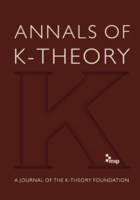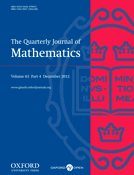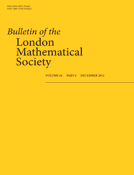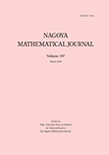
Epijournal de Geometrie Algebrique
Scope & Guideline
Advancing Algebraic Frontiers
Introduction
Aims and Scopes
- Algebraic Geometry and Its Applications:
The journal focuses on algebraic geometry, including the study of varieties, schemes, and their applications in various mathematical contexts such as number theory and representation theory. - Derived and Homotopical Methods:
There is a significant emphasis on derived algebraic geometry and homotopical techniques, showcasing how these modern approaches can yield new insights into classical problems. - Moduli Spaces and Invariant Theory:
Research on moduli spaces, particularly concerning vector bundles and stable sheaves, is a core theme, addressing their geometric and topological properties. - Tropical and Non-Archimedean Geometry:
The journal also explores tropical geometry and non-Archimedean methods, which have gained traction for their utility in understanding algebraic structures in a more combinatorial context. - Interplay with Other Mathematical Disciplines:
Papers often explore the connections between algebraic geometry and other fields such as symplectic geometry, representation theory, and mathematical physics.
Trending and Emerging
- Derived Algebraic Geometry:
An increasing number of publications are focusing on derived algebraic geometry, which employs homotopical techniques to understand algebraic structures more deeply. - Tropical Geometry:
Tropical geometry is gaining traction as a powerful tool in algebraic geometry, with applications that bridge combinatorial and algebraic methods. - Moduli Spaces of Vector Bundles:
There is a notable rise in research concerning moduli spaces, particularly in the context of vector bundles on various geometric backgrounds, highlighting their importance in contemporary algebraic geometry. - Non-Archimedean and p-adic Methods:
The use of non-Archimedean methods and p-adic geometry is emerging as a fertile area of research, which is crucial for understanding algebraic varieties over finite fields. - Invariant Theory and Symmetries:
Research on automorphism groups and symmetries of algebraic varieties is on the rise, reflecting a growing interest in the structural aspects of algebraic geometry.
Declining or Waning
- Classical Algebraic Surfaces:
Research specifically centered on classical algebraic surfaces, such as del Pezzo surfaces, has seen a decrease, possibly due to the increasing focus on higher-dimensional varieties and more complex structures. - Elementary Algebraic Geometry:
Basic studies in algebraic geometry, which once formed the backbone of the field, are appearing less frequently as researchers delve into more specialized and advanced topics. - Traditional Cohomological Methods:
While cohomology remains important, the application of traditional methods without integration of modern techniques like derived categories is becoming less common, reflecting a shift towards more innovative approaches.
Similar Journals

Annals of K-Theory
Unveiling New Dimensions in Mathematical SciencesAnnals of K-Theory, published by Mathematical Science Publishers, is an esteemed academic journal that serves as a vital platform for advancing research in the fields of analysis, geometry, and topology. Since its inception in 2016, the journal has successfully merged rigorous mathematical exploration with practical application, catering to a diverse audience of researchers, professionals, and students. With an impressive track record as a Q2 journal in Analysis and Geometry and Topology, and achieving a Q1 ranking in Assessment and Diagnosis in 2023, Annals of K-Theory continues to be recognized for its significant contributions to the mathematical sciences community. Although currently not open access, the journal provides relevant and accessible content that encourages rigorous dialogue and collaboration among mathematicians. As indicated by its Scopus rankings, it holds a commendable position within its field, demonstrating a commitment to quality research that pushes the boundaries of mathematical knowledge and application.

TRANSFORMATION GROUPS
Connecting Researchers with Cutting-edge Transformative ConceptsTRANSFORMATION GROUPS, published by Springer Birkhäuser, is a leading academic journal specializing in the fields of algebra, geometry, and topology. With its ISSN 1083-4362 and E-ISSN 1531-586X, the journal has established itself as an essential resource for researchers and academicians, achieving a remarkable Impact Factor and ranking in prestigious categories: Q1 in Algebra and Number Theory and Q2 in Geometry and Topology as of 2023. Over its history from 1997 to 2024, TRANSFORMATION GROUPS has delivered cutting-edge research and innovative insights, currently holding Scopus rankings of #40/119 in Algebra and Number Theory and #38/106 in Geometry and Topology. This journal caters to those seeking to enhance their understanding of mathematical transformations and their applications, making it a vital platform for scholarly discourse within the mathematical community.

JOURNAL OF DIFFERENTIAL GEOMETRY
Pioneering insights in geometry, algebra, and analysis.JOURNAL OF DIFFERENTIAL GEOMETRY, a premier publication by INT PRESS BOSTON, INC, has established itself as a leading forum for the dissemination of high-quality research in the fields of differential geometry, algebra, and analysis. With an impressive history that spans from 1967 to 2024, this journal is recognized for its rigorous peer-reviewed articles, contributing significantly to the advancement of mathematical theories and innovative approaches. Notably, the journal boasts a Q1 ranking in key categories such as Algebra and Number Theory, Geometry and Topology, and Analysis, reflecting its pivotal role within the mathematics community. Its Scopus rankings reinforce its reputation, placing it among the top-tier journals in its respective fields, with a 97th percentile ranking in Algebra and Number Theory, further emphasizing its influence. While the journal does not offer Open Access options, it remains a critical resource for researchers, professionals, and students aiming to stay at the forefront of developments in differential geometry and related domains. Engage with groundbreaking research and explore new methodologies that are shaping the future of mathematics.

MICHIGAN MATHEMATICAL JOURNAL
Pioneering Insights in the World of MathematicsThe MICHIGAN MATHEMATICAL JOURNAL is a prestigious and influential publication in the field of mathematics, founded by the University of Michigan. With an ISSN of 0026-2285 and an E-ISSN of 1945-2365, this journal is recognized for its high-quality research and has achieved a commendable Q1 ranking in the category of Mathematics (miscellaneous) as of 2023. Published by the esteemed Michigan Mathematical Journal, it provides a platform for the dissemination of innovative mathematical theories and findings, playing a crucial role in advancing knowledge and scholarship within the mathematical community. With coverage spanning from 1996 to 2024, the journal emphasizes rigorous theoretical development and fosters collaboration among researchers, professionals, and students alike. While not an open-access journal, its contributions are invaluable for those looking to stay abreast of cutting-edge mathematical research.

QUARTERLY JOURNAL OF MATHEMATICS
Fostering Insights in the World of MathematicsQuarterly Journal of Mathematics, published by Oxford University Press, stands as a pivotal resource for the mathematical community, focusing on a broad spectrum of topics in the field of mathematics. With its esteemed history dating back to 1930, this journal continues to foster innovative research and discussions, providing a platform for scholars to share their findings and insights. Although the journal currently holds a Q3 classification in mathematics (miscellaneous) and is ranked #207 among general mathematics publications in the Scopus database, its commitment to quality and rigorous peer review ensures that it remains relevant and insightful. Researchers, professionals, and students alike will find the Quarterly Journal of Mathematics an invaluable tool for advancing knowledge and understanding in various mathematical disciplines, making it an essential addition to any academic library.

Journal of Homotopy and Related Structures
Pioneering Insights in Geometry and Number TheoryJournal of Homotopy and Related Structures is a distinguished academic journal published by Springer Heidelberg, specializing in the fields of algebra, number theory, geometry, and topology. With a focus on the intricate relationships and structures within these disciplines, the journal aims to facilitate the dissemination of original research and provide a platform for scholarly exchange among mathematicians. Since its inception in 2012, the journal has positioned itself in the Q2 category for both Algebra and Number Theory and Geometry and Topology in 2023, reflecting its growing influence and commitment to high-quality publications. Although it operates under a subscription model, the research published in this journal is highly cited, contributing to its notable rankings—#57 in Geometry and Topology and #65 in Algebra and Number Theory on the Scopus index. This journal is an essential resource for researchers, professionals, and students who wish to stay updated with the latest advancements and trends in homotopy theory and related mathematical structures.

Forum of Mathematics Sigma
Exploring the depths of mathematical excellence.Forum of Mathematics Sigma is a premier open access journal published by Cambridge University Press that has been at the forefront of mathematical research since its inception in 2013. With a strong emphasis on advancing the fields of mathematics, the journal consistently achieves Q1 rankings across multiple categories, including Algebra and Number Theory, Analysis, and Computational Mathematics. This distinction highlights its impact and relevance within the scholarly community. The journal prides itself on providing a platform for innovative research, fostering collaboration among researchers and practitioners across various mathematical disciplines. Open access publication ensures that cutting-edge findings are widely available to readers globally, enhancing the dissemination of knowledge. With an address in the heart of Cambridge, England, Forum of Mathematics Sigma is dedicated to promoting high-quality research and making significant contributions to the development of mathematics.

BULLETIN OF THE LONDON MATHEMATICAL SOCIETY
Illuminating Trends in Mathematics for Over Fifty YearsThe BULLETIN OF THE LONDON MATHEMATICAL SOCIETY, published by Wiley, is a distinguished journal that serves as a vital resource in the field of mathematics. With its ISSN 0024-6093 and E-ISSN 1469-2120, this journal has consistently provided a platform for innovative research and scholarly discourse since its inception in 1969. Recognized for its quality, it currently holds an impressive Q1 ranking in the mathematics category, a testament to its significance in disseminating influential findings and trends in the mathematical sciences. Researchers and practitioners can rely on the BULLETIN for its comprehensive coverage of both theoretical and applied mathematics, which caters to a diverse audience ranging from professionals to students alike. Though it does not currently offer Open Access options, its articles can be accessed through institutional subscriptions, ensuring that significant works reach the academic community effectively. With contributions that span over five decades, the journal continues to shape mathematical research and inspire future advancements in the discipline.

Algebraic Geometry
Bridging Concepts: Where Algebra Meets GeometryAlgebraic Geometry, published by the European Mathematical Society, stands as a pivotal platform in the realm of modern mathematics, focusing on the intricate interplay between algebra and geometry. Since its inception in 2014, this Open Access journal has garnered significant attention, reflected in its prestigious rankings, including Q1 status in the categories of Algebra and Number Theory and Geometry and Topology, as per the 2023 metrics. With an impressive Scopus ranking of #18/119 in Algebra and Number Theory and #18/106 in Geometry and Topology, it ensures high visibility and accessibility of groundbreaking research. Based in Germany, at the esteemed Technical University of Berlin, the journal serves as a beacon for researchers, professionals, and students aiming to push the boundaries of knowledge in these dynamic fields. The scope of the journal encompasses diverse topics, including but not limited to, the latest developments in algebraic structures and geometric configurations, promising to enrich the academic discourse and foster innovation. As we converge towards its tenth anniversary in 2024, Algebraic Geometry continues to evolve and solidify its role as an essential resource for the mathematical community.

NAGOYA MATHEMATICAL JOURNAL
Exploring Innovative Frontiers in MathematicsNAGOA MATHEMATICAL JOURNAL, published by Cambridge University Press, is a prestigious journal that has been at the forefront of advancing mathematical scholarship since its inception in 1950. With an ISSN of 0027-7630 and an E-ISSN of 2152-6842, this journal has gained recognition for its high-quality research contributions in the field of mathematics, achieving a Q1 classification in Mathematics (miscellaneous) as of 2023. The journal’s impact is further reflected in its Scopus rank of #164 out of 399 in the General Mathematics category, positioning it within the 59th percentile of its peers. Scholars, researchers, and students can access a range of innovative mathematical studies that explore diverse topics, fostering a vibrant dialogue within the mathematical community. By catering to a global audience, the NAGOYA MATHEMATICAL JOURNAL continues to play a critical role in shaping contemporary mathematical discourse and research.